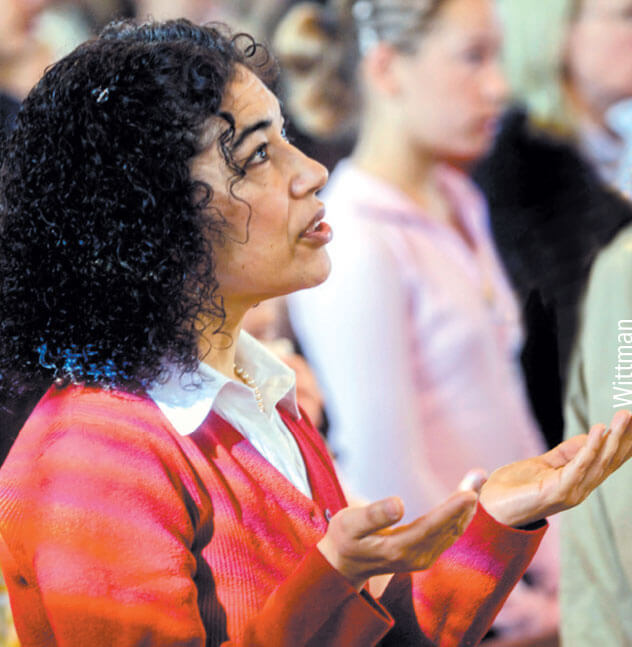
Several details invite us to make connections between the two stories in Sunday’s gospel. Both are about daughters. The child is a daughter of Jairus and of the synagogue he leads. Jesus addresses the hemorrhaging woman as daughter after she tells the whole truth of her healing. She is a daughter of his new community — a believer.
Twelve is an important number in both stories. The child is 12 years old, an approximate age for the onset of menstruation. The woman has suffered a flow of blood for 12 years and has for these years been excluded, according to the law of Moses, from the worship of her people in the temple.
Leviticus 15.19-31 says that a flow of blood makes a woman unclean, contaminates anyone she touches, and prevents her from entering and defiling the temple. In the case of the hemorrhaging woman, the opposite occurs. Her touch doesn’t make Jesus unclean; rather Jesus heals her and makes her whole.
Mark also connects these two stories with Jesus’ own story. The Greek word mastigos, which Mark uses to name the woman’s flow of blood, labels it a scourge. In Acts 22.24 and Hebrews 11.36 this word refers to floggings or scourgings. The word connotes suffering like Jesus’ own in his passion and death. The woman’s lifeblood keeps hemorrhaging from her body just as Jesus’ lifeblood pours out in his suffering and death.
While the woman’s story emphasizes a long-time daily suffering, the child’s story emphasizes Jesus raising her up from near death. Jesus commands her, “Arise.” This is the same word that describes Jesus raising up Peter’s mother-in-law and his own rising from the dead. Together the stories of the two daughters echo in ordinary people’s lives Jesus’ suffering, death, and resurrection.
Both stories involve generations — the stories of Jairus and his blood daughter and Jesus and his faith daughter. By asking Jesus to help his daughter and trusting he can, Jairus changes his little girl’s future just as Jesus’ healing transforms the woman’s suffering and exclusion from the community. As a Christian, the little girl can grow up in a community that does not exclude her when she menstruates.
- Who do you see suffering Jesus’ passion today?
- What new life would you like to ask of Jesus for your children?
- What future in the Christian community do you want for your daughters?
- What do you make of Jesus’ willingness to heal and to touch and be touched?
The gospel writer tells the stories of the two daughters together as a story within a story. In both stories the people are desperate. Jairus and his wife fear for their daughter’s life. The woman with the hemorrhage despairs of ending the flow of blood. Both the desperate parents and the despairing woman respond to Jesus’ healing and life-giving power with amazement.
Amazement is the threshold where faith in Jesus begins. Repeatedly Mark’s gospel creates these threshold moments to call us hearers of the word to faith.
The story of the hemorrhaging woman interrupts and delays Jesus’ response to Jairus. She seeks Jesus out as a last desperate act. Imagine how she feels after 12 years of losing blood and energy. Doctors have failed her. She has spent her resources. Her condition has worsened. The woman takes matters into her own hands and from behind Jesus she touches his garment, a gesture significant and symbolic.
The people for whom Mark writes in AD 70 will meet Jesus in story and sacrament, at a distance, rather than face to face like the eyewitnesses.
The woman moves from desperation to fear and trembling, to testifying to the whole truth of what has happened to her. She proclaims the good news of her healing publicly in the midst of the crowd. Her faith heals her. Jesus addresses her as daughter. She belongs to his family of faith. She is one of only four people in Mark’s gospel who tell who Jesus is.
- What is a visible sacrament of your faith as touching Jesus’ garment was for the hemorrhaging woman?
- What witness do you give to Jesus’ importance in your life?
Messengers interrupt Jesus’ last words to the woman healed of hemorrhage with news that Jairus’s daughter had grown worse and died. The parents’ worst fears have come true. Jesus invites Jairus to move from fear to faith. He heals the girl in the privacy of Jairus’s home with her parents, Peter, James, and John with him. All these witnesses move from fear to overwhelming amazement. Mark suspends them at this threshold of faith and they follow Jesus’ orders to tell no one.
The woman’s healing is key in this story within a story. The woman who no longer has a flow of blood not only experiences awe and amazement but models the response Mark wants. In her witness Mark points to the power of people’s faith in Jesus, even at a distance in time. She is an anonymous one of us who models the full step into faith and witness in the community. She is an ordinary person who speaks her faith and builds up the community in her generation. Her witness is the model Mark wants each hearer to follow.
- How has the faith testimony of others nourished your faith or the faith of your parish?
- What comments do you hear from others about the witness you give to your faith in Jesus?
